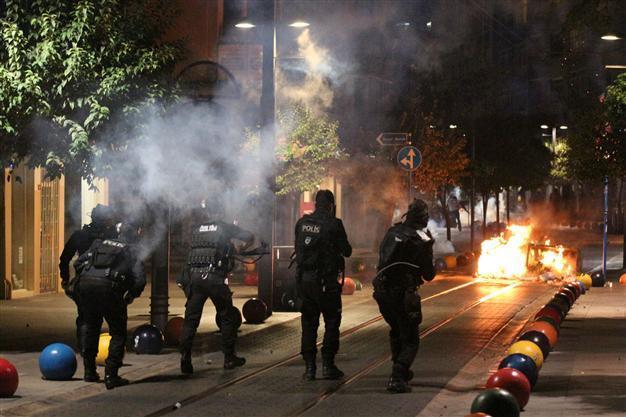Amnesty: Turkish police used ‘excessive force’ in Kobane protests
ISTANBUL – Anadolu Agency

DHA photo
Amnesty International has accused Turkish security forces of using excessive force to police major street protests which erupted in Turkey’s southeast last year. A 22-page report released by Amnesty in Istanbul on July 7 was also critical of what it termed “a lack of effective investigations into deaths and injuries that occurred.”The deadly protests erupted during last year’s Eid al-Adha holiday after Islamic State of Iraq and the Levant (ISIL) militants entered parts of the Syrian Kurdish town of Kobane on Oct. 6, 2014. The protesters had accused the Turkish government of failing to take action against the advance of the jihadists near the border, which became the scene of fierce street battles between Kurdish groups and ISIL militants.
A week of protests and linked large-scale violence left more than 40 people dead, including protesters, political opponents, bystanders and three police officers, the report said. The clashes also saw scores of injuries and the destruction of public and private property across southeastern Turkey and beyond. The protests also caused financial damage in several provinces, as government buildings, vehicles and even Red Crescent vans were set ablaze. Speaking in Istanbul on July 7, Andrew Gardner, Amnesty International’s researcher on Turkey, said the report was published after a long investigation in the region and aimed to prevent the reoccurrence of similar incidents. The 22-page report was based on interviews with victims of the violence, their family members, lawyers, activists and representatives of municipalities and the Interior Ministry in the region.
Amnesty said its research was carried out in Diyarbakır, Gaziantep and Siirt in October 2014 and in Cizre, Diyarbakır and Siirt in February 2015.
According to the report, Amnesty received numerous accounts of police officers using firearms in situations where there was no imminent threat to life or serious injury, in order to disperse hostile crowds or to protect public property.
“The circumstances that led to the use of firearms in many cases still remains unclear almost a year after the Kobane protests due to the authorities’ failure to effectively investigate the cases of alleged abusive police use of force,” said the report.
“However, there is strong evidence that police used excessive or unnecessary force,” Gardner said. “There is an urgent need for the policing operations to be investigated in terms of their ability to protect individuals, and for lessons to be learned, planning undertaken and then applied in the event of further violent clashes occurring in the future,” Gardner said, adding arguments that police intervention in certain protests would escalate tensions were “credible.”
“But that does not excuse or explain why the police failed to act when called on to protect individuals under attack or when violence reached a level that deaths or injuries were inevitable,” he said. Gardner said the response from the authorities since the protests has been “equally bad.”
“Provisions within the ‘domestic security package’ granting police extra authority to use firearms is an invitation to apply arbitrary and abusive force, increasing the likelihood of abuses still further,” he said.
Following the protests, in March 2015 Turkey’s parliament passed provisions giving the police more authority.
According to the bill, police can use weapons against those who attack schools, public buildings and places of worship with Molotovs, explosives, inflammable materials and other weapons. Those who cover their faces partly or entirely during demonstrations that turn into a “propaganda march” for a terrorist organization may face sentences of up to five years in prison.
















